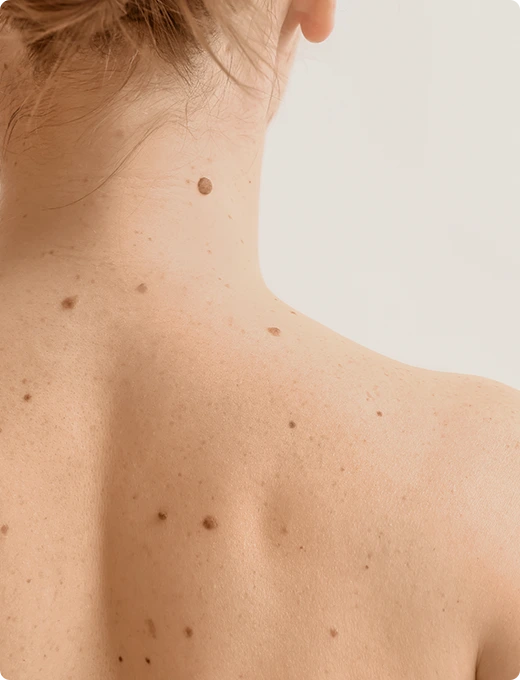Melanoma Treatment in Fresno, CA


WHAT IS MELANOMA?
CAUSES OF MELANOMA

- Excessive UV exposure
- A history of sunburns
- Having a fair complexion
- A family history of melanoma
- The presence of skin moles (round or oval growth that ranges in color from pink to brown and black)
PROGRESSION OF MELANOMA SKIN CANCER
Stage 0 (Melanoma in Situ)
- Abnormal cells are present in the outermost layer of skin (epidermis) but have not spread to deeper layers.
- Often referred to as "precancerous" because it may develop into an invasive melanoma over time.
- Can be surgically removed to prevent progression.
Stage I Melanoma
- The tumor is small, thin, and has not ulcerated (not broken the skin's surface).
- The estimated 5-year survival rate for this stage is nearly 100%.
Stage II Melanoma
- The tumor has grown thicker and expanded into the dermis (inner skin layer)
- Cancer has not spread to the lymph nodes or other parts of the body.
- The estimated 5-year survival rate is 80-98%.
Stage III Melanoma
- The cancer has spread to one or more nearby lymph nodes.
- Has not affected other organs.
- Survival rates are lower (65% to 75%) than earlier stages and depend on the size and number of lymph nodes involved.
Stage IV Melanoma
- The melanoma has spread beyond the original location and nearby lymph nodes to other organs, such as the lung, liver, brain, bone, or gastrointestinal tract.
- It is considered advanced, metastatic cancer.
- Estimated 5-year survival rates are the lowest of all stages - nearly 22.5%, depending on how far it has spread.

EARLY DETECTION
IS KEY
MELANOMA TREATMENT PROCEDURE
Upon confirming a melanoma diagnosis, our first step is to develop a personalized treatment plan tailored to the patient’s specific condition. The plan is based on several factors, including the stage of cancer, its location, overall health, and personal preferences. Our multidisciplinary team of dermatologists, oncologists, and surgeons collaborates closely to recommend the most effective options available.
Upon confirming a melanoma diagFor many patients, surgery is the primary treatment for melanoma. The type of operation depends on the tumor’s thickness and stage:
- Excisional Surgery: The most common treatment for early-stage melanomas. It involves removing the cancerous tissue along with a margin of healthy skin to ensure all cancer cells are eliminated.
- Mohs Surgery: This treatment is designed for melanomas located in cosmetically sensitive areas. Mohs surgery allows for the removal of cancerous cells layer by layer, preserving as much healthy tissue as possible.
- Sentinel Lymph Node Biopsy: If there is a concern that the primary tumor has spread, a sentinel lymph node biopsy may be performed during surgery to check for cancer cells in the lymph node
nosis, our first step is to develop a personalized treatment plan tailored to the patient’s specific condition. The plan is based on several factors, including the stage of cancer, its location, overall health, and personal preferences. Our multidisciplinary team of dermatologists, oncologists, and surgeons collaborates closely to recommend the most effective options available.
For advanced melanoma or cases where surgery is not an option, we offer cutting-edge treatments, including:
- Immunotherapy: Boosts the body’s immune system to fight cancer cells more effectively.
- Targeted Therapy: Blocks specific genetic mutations in melanomas and stops the tumor from growing.
- Radiation Therapy: Used in certain cases to destroy cancer cells or relieve symptoms of advanced melanoma.
Each of these advanced therapies may also be used as adjuvant therapy, which means that it can be added after the primary surgical treatment to reduce the risk of cancer coming back

RECOVERY
AFTER MELANOMA
TREATMENT
BENEFITS OF MELANOMA TREATMENT
Kill Cancer Cells
Prevent Spread
Extend Life Expectancy
CANDIDATES FOR MELANOMA TREATMENT

- Patients with early-stage melanoma
- People with regional spread into nearby lymph nodes
- Individuals with distant metastatic disease
-
People with melanomas that have returned after
initial treatment
-
Patients with melanomas that cannot be removed
surgically
COST OF MELANOMA TREATMENT

Approximate Prices
- Surgical Excision:The cost of surgical excision of melanoma ranges from $1,500 to $3,500, depending on the complexity of the operation and location.
- Mohs Surgery: The price of treating skin cancer with Mohs surgery, particularly those in cosmetically sensitive areas, starts at $2,000 and may reach $5,000 or more.
- Immunotherapy and Targeted Therapy: These treatments, often used for advanced melanoma, can be significantly more expensive. Depending on the specific drugs and duration of therapy, they range from $10,000 to over $100,000 for a full course.
- Radiation Therapy: The cost of radiation therapy also varies, from $10,000 to $50,000, based on the number of sessions required.


